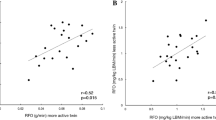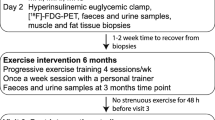Abstract
Exercise-induced positive changes in skeletal muscle properties and metabolism decrease the risk for disability, cardiometabolic diseases and mortality. Here, we studied muscle properties and glucose homeostasis in a non-exercise stage in twin pairs with co-twins discordant for physical activity habits for at least 32 years of their adult lives. Isometric knee extension force, MR imaging of midthigh tissue composition and muscle volume, and fasting blood samples were acquired from 16 same-sex (seven monozygotic, nine dizygotic) middle-aged and older twin pairs. The consistently active twins had 20 % higher knee extension forces than their inactive co-twins (p = 0.006) although the active twins had only 4 % higher midthigh muscle cross-sectional areas (p = 0.072). These results were similar in intrapair analysis in which only the seven identical twin pairs were included. The ratio between the area of midthigh fat and muscle tissues was significantly lower among the active twins (0.65 vs. 0.48, p = 0.006). The active twins had also lower fasting plasma glucose levels (5.1 vs 5.6 mmol/l, p = 0.041). The area of midthigh intramuscular (extramyocellular) fat was associated with the markers of glucose homeostasis, especially with glycated hemoglobin, and these associations were emphasized by the diabetic and inactive twins. Regular exercise throughout the adult life retains muscle strength and quality but not necessarily mass. The regular use of muscles also prevents from the accumulation of intramuscular fat which might be related to maintained glucose metabolism and, thus, prevention of metabolic disorders.


Similar content being viewed by others
References
Boule NG, Weisnagel SJ, Lakka TA, Tremblay A, Bergman RN, Rankinen T, Leon AS, Skinner JS, Wilmore JH, Rao DC, Bouchard C (2005) Effects of exercise training on glucose homeostasis. The HERITAGE family study. Diabetes Care 28:108–114
Church TS, Blair SN, Cocreham S, Johannsen N, Johnson W, Kramer K, Mikus CR, Myers V, Nauta M, Rodarte RQ, Sparks L, Thompson A, Earnest CP (2010) Effects of aerobic and resistance training on hemoglobin A1c levels in patients with type 2 diabetes. A randomized controlled trial. JAMA 304:2253–2262
Delmonico MJ, Harris TB, Visser M, Park SW, Conroy MB, Velasquez-Mieyer P, Boudreau R, Manini TM, Nevitt M, Newman AB, Goodpaster BH (2009) Longitudinal study of muscle strength, quality, and adipose tissue infiltration. Am J Clin Nutr 90:1579–1585
Deschenes MR (2004) Effects of aging on muscle fibre type and size. Sports Med 34:809–824
Dube JJ, Amati F, Stefanovic-Racic M, Toledo FGS, Sauers SE, Goodpaster BH (2008) Exercise-induced alterations in intramyocellular lipids and insulin resistance: the athlete’s paradox revisited. Am J Physiol Endocrinol Metab 294:E882–E888
Eckardt K, Taube A, Eckel J (2011) Obesity-associated insulin resistance in skeletal muscle: role of lipid accumulation and physical inactivity. Rev Endocr Metab Disord 12:163–172
Faulkner JA, Larkin LM, Claflin DR, Brooks SV (2007) Age-related changes in the structure and function of skeletal muscles. Clin Exp Pharmacol Physiol 34:1091–1096
Frontera WR, Reid KF, Phillips EM, Krivickas LS, Hughes VA, Roubenoff R, Fielding RA (2008) Muscle fiber size and function in elderly humans: a longitudinal study. J Appl Physiol 105:637–642
Goodpaster BH, Brown NF (2005) Skeletal muscle lipid and its association with insulin resistance: what is the role for exercise? Exerc Sport Sci Rev 33:150–154
Goodpaster BH, Chomentowski P, Ward BK, Rossi A, Glynn NW, Delmonico MJ, Kritchevsky SB, Pahor M, Newman AB (2008) Effects of physical activity on strength and skeletal muscle fat infiltration in older adults: a randomized controlled trial. J Appl Physiol 105:1498–1503
Goodpaster BH, He J, Watkins S, Kelley DE (2001) Skeletal muscle lipid content and insulin resistance: evidence for a paradox in endurance-trained athletes. J Clin Endocrinol Metab 86:5755–5761
Goodpaster BH, Park SW, Harris TB, Kritchevsky SB, Nevitt M, Schwartz AV, Simonsick EM, Tylavsky FA, Visser M, Newman AB (2006) The loss of skeletal muscle strength, mass, and quality in older adults: the health, aging and body composition study. J Gerontol A Biol Sci Med Sci 61:1059–1064
Goodpaster BH, Thaete FL, Kelley DE (2000) Thigh adipose tissue distribution is associated with insulin resistance in obesity and in type 2 diabetes mellitus. Am J Clin Nutr 71:885–892
Hawley JA, Lessard SJ (2008) Exercise training-induced improvements in insulin action. Acta Physiol 192:127–135
Henriksen EJ (2002) Effects of acute exercise and exercise training on insulin resistance. J Appl Physiol 93:788–796
Hughes VA, Frontera WR, Wood M, Evans WJ, Dallal GE, Roubenoff R, Fiatarone Singh MA (2001) Longitudinal muscle strength changes in older adults: influence of muscle mass, physical activity and health. J Gerontol 56A:B209–B217
Janssen I (2006) Influence of sarcopenia on the development of physical disability: the cardiovascular health study. J Am Geriatr Soc 54:56–62
Jeon CY, Lokken RP, Hu FB, van Dam RM (2007) Physical activity of moderate intensity and risk of type 2 diabetes: a systematic review. Diabetes Care 30:744–752
Kujala UM (2009) Evidence on the effects of exercise therapy in the treatment of chronic disease. Br J Sports Med 43:550–555
Kujala UM, Kaprio J, Koskenvuo M (2002) Modifiable risk factors as predictors of all-cause mortality: the roles of genetics and childhood environment. Am J Epidemiol 156:985–993
Kujala UM, Kaprio J, Sarna S, Koskenvuo M (1998) Relationship of leisure-time physical activity and mortality: the Finnish twin cohort. JAMA 279:2440–444
Larsen S, Stride N, Hey-Mogensen M, Hansen CN, Andersen JL, Madsbad S, Worm D, Helge JW, Dela F (2011) Increased mitochondrial substrate sensitivity in skeletal muscle of patients with type 2 diabetes. Diabetologia 54:1427–1436
Leskinen T, Waller K, Mutikainen S, Aaltonen S, Ronkainen PHA, Alen M, Sipilä S, Kovanen V, Perhonen M, Pietiläinen KH, Cheng S, Suominen H, Kainulainen H, Kaprio J, Kujala UM (2009a) Effects of 32-year leisure time physical activity discordance in twin pairs on health (TWINACTIVE study): aims, design and results for physical fitness. Twin Res Hum Genet 12:108–117
Leskinen T, Sipilä S, Alen M, Cheng S, Pietiläinen KH, Usenius JP, Suominen H, Kovanen V, Kainulainen H, Kaprio J, Kujala UM (2009b) Leisure-time physical activity and high-risk fat: a longitudinal population-based twin study. Int J Obes (Lond) 33:1211–1218
Leskinen T, Rinnankoski-Tuikka R, Rintala M, Seppanen-Laakso T, Pöllänen E, Alen M, Sipilä S, Kaprio J, Kovanen V, Rahkila P, Oresic M, Kainulainen H, Kujala UM (2010) Physically active lifestyle, muscle properties and glucose metabolism. PLoS One 5(9):e12609
Mikus CR, Oberlin DJ, Libla JL, Taylor AM, Booth FW, Thyfault JP (2012) Lowering physical activity impairs glycemic control in healthy volunteers. Med Sci Sports Exerc 44:225–231
Mora S, Cook N, Buring JE, Ridker PM, Lee IM (2007) Physical activity and reduced risk of cardiovascular events: potential mediating mechanisms. Circulation 116:2110–2118
Muniyappa R, Lee S, Chen H, Quon MJ (2008) Current approaches for assessing insulin sensitivity and resistance in vivo: advantages, limitations, and appropriate usage. Am J Physiol Endocrinol Metab 294:E15–E26
Newman AB, Kupelian V, Visser M, Simonsick EM, Goodpaster BH, Kritshevsky SB, Tylavsky FA, Rubin SM, Harris TB (2006) Strength, but not muscle mass is associated with mortality in the health, aging and body composition study cohort. J Gerontol A: Biol Med Sci 61:72–77
Nguyen TV, Howard GM, Kelly PJ, Eisman JA (1998) Bone mass, lean mass, and fat mass: same genes or same environments? Am J Epidemiol 147:2–16
Patel MJ, Slentz CA, Kraus WE (2011) Metabolic deterioration of the sedentary control group in clinical trials. J Appl Physiol 111:1211–1217
Petersen KF, Shulman GI (2006) Etiology of insulin resistance. Am J Med 119:10S–16S
Physical Activity Guidelines Advisory Committee (2008) Physical activity guidelines advisory committee report. Department of Health and Human Services, Washington
Rantanen T, Guralnik JM, Foley D, Masaki K, Leveille S, Curb JD, White L (1999) Midlife hand grip strength as a predictor of old age disability. JAMA 281:558–560
Rector RS, Thyfault JP (2011) Does inactivity cause nonalcoholic fatty liver disease? J Appl Physiol 111:1828–1835
Rintala M, Lyytikäinen A, Leskinen T, Alen M, Pietiläinen KH, Kaprio J, Kujala UM (2011) Leisure-time physical activity and nutrition: a twin study. Pub Health Nutr 14:846–852
Ruiz JR, Sui X, Lobelo F, Morrow JR Jr, Jackson AW, Sjöström M, Blair SN (2008) Association between muscular strength and mortality in men: prospective cohort study. BMJ 337:92–95
Sipilä S, Multanen J, Kallinen M, Era P, Suominen H (1996) Effects of strength and endurance training on isometric muscle strength and walking speed in elderly women. Acta Physiol Scand 156:457–464
Sipilä S, Suominen H (1995) Effects of strength and endurance training on thigh and leg muscle mass and composition in elderly women. J Appl Physiol 78:334–340
Tarpenning KM, Hamilton-Wessler M, Wiswell RA, Hawkins SA (2004) Endurance training delays age of decline in leg strength and muscle morphology. Med Sci Sports Exerc 36:74–78
Taube A, Eckardt K, Eckel J (2009) Role of lipid-derived mediators in skeletal muscle insulin resistance. Am J Physiol Endocrinol Metab 297:E1004–E1012
Thomas D, Elliot EJ, Naughton GA (2006) Exercise for type 2 diabetes mellitus. Cochrane Database Syst Rev 3:CD002968
Tiainen K, Perola M, Kovanen VM, Sipilä S, Tuononen KA, Rikalainen K, Kauppinen MA, Widen EI, Kaprio J, Rantanen T, Kujala UM (2008) Genetics of maximal walking speed and skeletal muscle characteristics in older women. Twin Res Hum Genet 11:321–334
Tiainen K, Sipila S, Alen M, Heikkinen E, Kaprio J, Koskenvuo M, Tolvanen A, Pajala S, Rantanen T (2004) Heritability of maximal isometric muscle strength in older female twins. J Appl Physiol 96:173–180
Visser M, Goodpaster BH, Kritchevsky SB, Newman AB, Nevitt M, Rubin SM, Simonsick EM, Harris TB (2005) Muscle mass, muscle strength, and muscle fat infiltration as predictors of incident mobility limitations in well-functioning older persons. J Gerontol A Biol Sci Med Sci 60:324–333
Waller K, Kaprio J, Kujala UM (2008) Associations between long-term physical activity, waist circumference and weight gain: a 30-year longitudinal twin study. Int J Obes (Lond) 32:353–361
Waller K, Kaprio J, Lehtovirta M, Siventoinen K, Koskenvuo M, Kujala UM (2010) Leisure-time physical activity and type 2 diabetes during a 28-year follow-up in twins. Diabetologia 53:2531–2537
Williams RL (2000) A note on robust variance estimation for cluster-correlated data. Biometrics 56:645–646
Wolfe RR (2006) The underappreciated role of muscle in health and disease. Am J Clin Nutr 84:475–482
Acknowledgments
We acknowledge support from the EC FP7 Collaborative Project MYOAGE (GA-223576). The TWINACTIVE study was supported by the Academy of Finland (Grant 114 866 and Centre of Excellence in Complex Disease Genetics, (grant numbers: 213506, 129680)) and Finnish Ministry of Education. Tuija Leskinen was supported by the Finnish Cultural Foundation, Juho Vainio Foundation, and Yrjö Jahnsson Foundation. Dr Urho Kujala was supported by the Juho Vainio Foundation.
Author information
Authors and Affiliations
Corresponding author
About this article
Cite this article
Leskinen, T., Sipilä, S., Kaprio, J. et al. Physically active vs. inactive lifestyle, muscle properties, and glucose homeostasis in middle-aged and older twins. AGE 35, 1917–1926 (2013). https://doi.org/10.1007/s11357-012-9486-7
Received:
Accepted:
Published:
Issue Date:
DOI: https://doi.org/10.1007/s11357-012-9486-7




